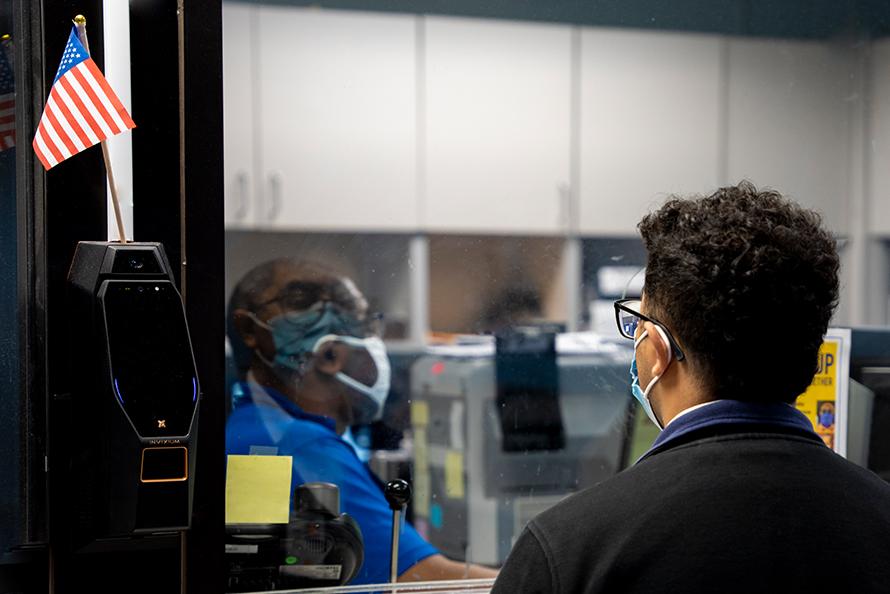Commercial application effectively streamlines and automates the badging application and renewal process
With threats changing and becoming more sophisticated year after year, Houston Airports places the utmost importance on airport security. One of the key players in ensuring the airport system’s stellar security record is also among the lesser-known entities within the airport system, the badging office.
Houston Airports Badging Offices at George Bush Intercontinental Airport, William P. Hobby Airport, and Ellington Airport process and renew approximately a thousand badges each month for new employees, contractors, concessionaires, and tenants. Every individual hired to work within the regulated areas at any of the three airports undergoes vetting, including fingerprints and background checks, prior to receiving a badge.
Houston Airports’ Chief Technology Officer Darryl Daniel recently discussed a vast improvement that Houston Airports made for the badging office in replacing the paper-based, manually intensive badging system with a contemporary, highly efficient commercial application that has effectively streamlined and automated the badging application and renewal process.
“Vetting individuals before giving them access to secure areas is a top challenge,” Daniel said. “It’s imperative to meet the challenge in an efficient and secure way. Houston Airports places heavy scrutiny on the highest level of security for our guests, our stakeholders, our community and our staff.”
“Airports guests – our passengers – are required to show their IDs and their boarding passes along their journeys from curb to gate and they can be certain that our internal processes ensure that the identities and credentials of the people serving them have been scrutinized as well.”
Cornell Watts, Senior IT Project Manager for the project which began in July 2021, concurred, and discussed the many positive ramifications of the project for Houston Airports and its more than 1,200 employees and 28,000 partners who need verified and managed access.
“We achieved fully electronic applications and automated workflows for all stakeholders,” said Watts “and there is now seamless integration with Honeywell, our access control partner , providing a flexible, connected badging platform which helps meet stringent compliance requirements.
Watts said that the successful project consolidated the processes for all three airports within the airport system.
“There is now a single solution for all HAS badge-related processes,” said Watts. “This includes an electronic Customs and Border Protection (CBP) form-specific application process which creates a highly simplified workflow resulting in faster badge issuance.”
The program has provided significant time savings, allowing the processing of badges to decrease from – 15 minutes per badge to 7 minutes per badge. Another cumulative benefit was allowing for approximately 153 hours per month (nearly 4 work weeks!) available to reallocate to underserved badging tasks and functions.
Watts said that the previous badging system was “very manual and mostly paper based.”
“We decided to go to a commercial solution that allows us to have electronic applications and focused on three stakeholder groups: the badging office, responsible for reviewing and processing the applications; authorized signers, responsible for completing applications with applicants; and the applicants themselves, responsible for providing info to authorized signers,” Watts said.
Furthermore, federal partners liker CBP require badge holders to undergo an even higher level of scrutiny.
“Authorized signers represent every different entity that is badged by HAS: internal, plus, airlines, other tenants and concessionaires, literally hundreds of entities,” Daniel said.
Watts said that CBP allowed them to create an electronic form-specific application process in the portal as well.
“They no longer need to collect identification or have a personal visit from the applicant themselves,” he continued. “Prior to the change, individuals had to provide the documentation for the HAS badge then go to the CBP Office and do the exact same thing.”
“But not anymore – the information is already in the system.”
The HAS badging agents can now focus on a lot of tasks they didn’t have time to do, Daniel said.
It sometimes took weeks, in some cases up to 30 days, for new hires to receive their badges. That is no longer the case – now, certain positions, like newly hired custodians, can get right to work. Formerly, they had to “shadow” an employee after they were hired until they were properly credentialed.
“We are the only airport to have a comprehensive badging process inside the authorized signing portal,” said Watts. “The portal allows electronic applications for new badges, renewals, lost/stolen/changes, customs clearance, and movement area training and approvals, to be completed for the entire Houston Airport System.”
The transition process was very methodical, leading up to 100 percent adoption of the new standards. At the appropriate juncture, the dedicated team started with pilot groups, used and refined the system to make initial enhancements, and spent three months rolling it out.
“And now, it’s really rolling,” said Watts.
Daniel credited Watts and his small team for providing the necessary focus and effort to carry out the essential training that took place – preparing, developing, and executing a well-researched and well-developed plan.
Watts gave credit to Christina Rice, Badging Office Manager at Hobby; Mary Gonzalez, Badging Office Manager at Bush; Ramona Smith, a super user at Hobby; Miguel Ramirez, a super user at Bush; Joseph Heidel from Information Technology; and Heather D’Alessandro, a contractor who assisted with the training.
Daniel said he was very proud of the successful collaboration that took place between technology, operations (the badging offices) and the tenants as well.
Reflecting upon the process, he said there were “so many value-adds” – a consolidated process for all three airports; a single solution for all HAS badge-related processes; a comprehensive dashboard and reporting capability; an electronic CBP application process; and a simplified workflow resulting in faster badge issuance.
“We (IT) are a service organization, and we’re here to enable the business units,” said Daniel. “It’s imperative for them to be a part of the process.”
“We have to be sure that only the right people receive keys to the house.”


